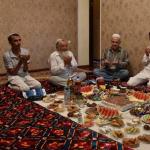September 9, 2016 marks the 25th anniversary of the adoption of the Statement and Resolution “On State Independence of the Republic of Tajikistan” at the session of the Supreme Council of the Republic of Tajikistan.
"AP" recalls the events that left their mark on the modern history of the country.
Confession
On September 9, 1991, at the session of the Supreme Council of the Republic of Tajikistan, the Statement and Resolution “On State Independence of the Republic of Tajikistan” were adopted. In honor of this historical event, September 9 was declared a state holiday in the republic - Independence Day of the Republic of Tajikistan.
On February 26, 1992, our country was admitted to the Organization for Security and Cooperation in Europe (OSCE).
On March 2, 1992, another important event occurred in the history of the republic - Tajikistan joined the member states of the United Nations (UN).
Civil war
Having not yet enjoyed the fruits of freedom, just a year after gaining independence, the inhabitants of the country were plunged into the abyss of civil strife. May 5, 1992 - June 27, 1997 - years of civil war.
The damage caused to the national economy of the republic during the war amounted to more than 10 billion dollars. But the main losses are human. Over more than 5 years of confrontation, according to various estimates, from 100 to 120 thousand residents of Tajikistan were killed, thousands of people were injured, hundreds of thousands were forced to leave their homes and flee the country.

On November 16 - December 2, 1992, the XVI session of the Shuroi Oli (Supreme Council) of the Republic of Tajikistan took place in Khujand, at which Rakhmon Nabiyev resigned as President of the Republic of Tajikistan, on November 19, 1992, the Chairman of the Supreme Council of the Republic of Tajikistan (in fact, the head of the republic) Emomali Rahmon was elected. Despite the decision of the XVI session to end the armed confrontation, military operations in the republic continued until June 27, 1997. On this day in Moscow, the President of the Republic of Tajikistan Emomali Rahmon and the head of the United Tajik Opposition (UTO) Said Abdullo Nuri signed a General Agreement on Peace and National Accord in Tajikistan.
The final agreement was signed after 8 rounds of negotiations between the government of the Republic of Tajikistan and the UTO (1994-1997). June 27 has been declared a state holiday in the republic - the Day of National Unity.
The most...
Over the years of independence, hundreds of large socio-cultural facilities have been built in Tajikistan.
Since the 2000s, Dushanbe has turned into one large construction site, where dozens of facilities have been built and continue to be built, including those that have no analogues not only in Central Asia, but also in the world as a whole.

Here is a partial list of them:
One of the tallest flagpoles in the world (165 meters);
The largest teahouse in the world is “Kokhi Navruz”;
The National Library is the largest library in Central Asia;
- “Qasri Millat” - recognized as one of the most beautiful presidential palaces.
In addition, during this period such large objects were built as the tallest skyscraper in the capital - “Dushanbe Plaza” (20 floors), the National Museum, the new building of the Ministry of Foreign Affairs, a column with the national coat of arms, and the new capital park “Gods of Poytakht”. The appearance of the central park, which received the name Rudaki, completely changed. Five-star hotels “Serena”, “Hyatt Regency”, “Sheraton” and others were built.
Many large structures were built in Dangara, Gissar, and Khujand.
Next year it is planned to complete the construction of the largest National Theater in Central Asia and the largest mosque in the region.
Hydropower is a priority in the country's development
Over the years of independence, dozens of large hydropower facilities have been commissioned in Tajikistan. Among them are Sangtuda HPP - 1 and Sangtuda HPP - 2.
The construction of Sangtuda HPP-1 was carried out over 4 years - from 2005 to 2009. The first hydraulic unit of the hydroelectric power station began generating electricity in January 2008. On July 31, 2009, with the participation of the presidents of Russia and Tajikistan - Dmitry Medvedev and Emomali Rakhmon - the station was solemnly put into operation. The power of the hydroelectric power station is 670 MW, which makes it the second largest hydroelectric station in Tajikistan after the Nurek hydroelectric power station.

Construction of the Sangtuda Hydroelectric Power Station - 2 officially began on February 20, 2006. Iran allocated $180 million for the construction of the facility, the Tajik side’s share was $40 million. The first unit of the hydroelectric power station was launched on September 5, 2011 in the presence of the presidents of Tajikistan and Iran. According to the project, the production capacity of the first stage of Sangtuda-2 is 110 MW. In September 2014, the second unit was launched, with a capacity of 110 MW.
In addition, many industrial enterprises were commissioned in the country, including in Dushanbe, Yavan, Gissar, Penjikent, Khujand, Vahdat and other cities and regions of the republic.
Russian military base remains until 2042
The presence of the Russian military base in Tajikistan - the largest outside Russia - has been extended until 2042. An agreement on this was concluded during the official visit of Russian President Vladimir Putin to Dushanbe in October 2012.
The previous agreement on the 201st Russian military base, which houses about 7 thousand military personnel, expired in 2014.
In practice, rent is not charged for the use of military installations. According to the agreement, base military personnel and members of their families will have a status similar to that of administrative and technical personnel of diplomatic missions.

In response, Moscow promised to increase the period of one-time stay of Tajik labor migrants in the Russian Federation to three years. Vladimir Putin also said during the visit that the Russian side will help Tajikistan modernize its armed forces.
It was also decided to cancel export duties on oil products imported into Tajikistan from Russia.
The parties came to an agreement after much debate.
Our border
The border issue remains the most important and problematic in Tajikistan.
The Tajik-Afghan border, 1,334 kilometers long, with a large set of border problems and the epicenter of instability - Afghanistan, was guarded by Russian border guards until 2005.
In June 2005, the security of the Tajik-Afghan border was completely transferred from Russian border guards to military personnel of the Committee for the Protection of the State Border of Tajikistan.
After the Russians left the border areas, Tajikistan proved that it is capable of protecting its borders, although armed attacks from the neighboring state continue to this day.
On January 11, 2014, in the village of Khojai Alo, Isfara district, a shootout occurred between border guards of Tajikistan and Kyrgyzstan. It was one of the most serious armed conflicts between the two sides in recent years.
As a result of the conflict and shootout, two Tajik border guards and three Kyrgyz border guards were wounded.
To this day, Tajikistan and Kyrgyzstan have not reached a consensus on the issue of border demarcation, which gives rise to regular conflicts, sometimes accompanied by bloodshed, between residents and border guards of both sides.
Tajikistan emerges from communication impasse
The years 2006 - 2010 were remembered for the construction and commissioning of the Dushanbe - Khujand - Chanak (Uzbekistan), Dushanbe - Jirgatal - Sary-Tash (Kyrgyzstan) highways, the Ozodi (Sharshar), Istiklol (Anzob), and Shahristan road tunnels " and "Chormagzak".
These highways provided year-round road communication between the northern and southern regions of Tajikistan with access to Uzbekistan and Kyrgyzstan.

The Istiklol and Shakhristan tunnels have shortened the journey between Dushanbe and Khujand to 4.5-5 hours. Currently, the Shakhristan tunnel is the longest road tunnel in the CIS countries.
Road to the South
On August 24, 2016, President E. Rahmon took part in the opening ceremony of the new Dushanbe - Kurgan-Tube - Kulyab railway.
With the opening of this road, a permanent railway connection is being established between Dushanbe and one of the largest regions of the country - Khatlon region.

Construction of the Dushanbe-Kurgan-Tube-Kulyab railway began in March 2009. As part of the construction of this railway line, three tunnels with a total length of 3.7 thousand meters and eight modern bridges with a total length of almost 700 meters were built. 985 million somoni were spent on laying the railway, including the construction of tunnels and bridges. The bridges and tunnels on this railway were built with a loan from the Chinese Exim Bank in the amount of 72 million somoni.
Escape of the century
On August 23, 2010, 25 armed especially dangerous criminals, having overcome the double cordon and killed several guards of the State Committee for National Security pre-trial detention center, were able to be free.

Among those who fled were 14 citizens of Tajikistan and 11 foreigners - citizens of Russia, Afghanistan and Uzbekistan. Among them are such well-known persons as the brother of the ex-commander of the presidential guard Gaffor Mirzoev, sentenced to life, Abdurasul, one of the organizers of the “escape of the century”, former Guantanamo prisoner Ibrokhim Nasreddinov, two closest relatives of the ex-head of the Ministry of Emergency Situations Mirzo Ziyoyev - Azamsho and Jonibek Ziyoyev. And also Zaidullo Azizov is the brother of the famous UTO field commander Negmat Azizov, who was killed during a special operation by government forces in 2009.
During the year, law enforcement and security agencies carried out a number of special operations, during which all the fugitives were detained or eliminated. Unfortunately, there were also casualties among the security forces.
A few days after the escape, the head of the State Committee for National Security, Khairiddin Abdurakhimov, and three of his deputies resigned.
Bloody massacre at Kamaroba
On September 19, 2010, in the Kamarob gorge of the Rasht region, an armed group fired at a convoy of the Ministry of Defense of the Republic of Tajikistan. As a result of the attack, according to official data, 25 military personnel were killed, and according to unofficial data, at least 40.
On September 22, operational groups and military units of all power structures of the republic launched a large-scale operation in the Rasht Valley and other regions of the country, and on the same day 5 militants were killed.

The former head of the ROBOP Rashta, Mirzokhuja Akhmadov, who had been on the run for some time, and 11 of his supporters voluntarily appeared at the Internal Affairs Directorate for the Rasht group of districts and joined the government forces. Later, according to some sources, he also contributed to the capture of Mullo Abdullo. During the special operation, 15 militants were killed, among whom Mullo Abdullo was identified.
On January 4, 2011, the Ministry of Internal Affairs of the Republic of Tajikistan reported that not far from the regional center of Garm, Alovuddin Davlatov (Ali Bedaki), who, together with former UTO commanders Mirzokhuja Akhmadov and Mullo Abdullo, was accused of attacking a military convoy, was killed. However, later a video appeared on the Internet in which Davlatov was interrogated by security forces.
Operation Khorog 2012
On the morning of July 24, 2012, law enforcement agencies of the Republic of Tatarstan, with the support of units of the Ministry of Defense of the Republic of Tajikistan, simultaneously began an assault in several microdistricts of the city of Khorog - UPD, Upper Khorog (Barkhorog) and Bread Factory, where former field commanders lived, and now informal leaders of the region Tolib Ayombekov (Bread Factory), Imomnazar Imomnazarov (UPD) and Makhmadbokir Makhmadbokirov (Barkhorog). In response, informal leaders and their supporters put up armed resistance. The firefight lasted 16 hours. As a result of the fighting, according to various sources, 18 military personnel and 23 civilians were killed.
The military operation in GBAO began after the murder on July 21, two kilometers from Khorog, of the head of the regional department of the State Committee for National Security, General Abdullo Nazarov.

After the start of the assault, on July 24, 2012, mobile, landline and Internet communications with Khorog were cut off. Communication with GBAO was restored on August 28, almost a month later.
In January 2013, the GBAO prosecutor announced that the investigation into the murder of General Nazarov had been completed and the case had been transferred to court. According to the results of the investigation, two residents of GBAO were accused of the murder of the general: Okil Ayombekov, the brother of Tolib Ayombekov, and Khamza Murodov (Gulnazar). Both defendants surrendered voluntarily to authorities in August 2012.
Ban on IRPT
On September 29, 2015, the Supreme Court of Tajikistan made a decision according to which the Islamic Renaissance Party of Tajikistan was declared extremist and terrorist, and its activities were prohibited in the country. With the same decision, the court banned the publication of the weekly Najot, the IRPT’s printed organ, and blocked the party’s website.
Authorities said the IRPT was linked to the group of former Tajik Deputy Defense Minister Abduhalim Nazarzoda, which was accused of attempting a military coup last September.

The Prosecutor General's Office and the Supreme Court of Tajikistan reported that 170 people were detained and convicted in connection with the armed rebellion. The trial of 13 members of the Supreme Political Council of the IRPT ended on June 2 of this year, the court sentenced two deputy leaders of the party Muhiddin Kabiri - Saidumar Husaini and Mahmadali Khait - to life imprisonment, the rest received various prison terms - from 18 to 28 years. Kabiri himself is on the international wanted list.
According to the Law of the Republic of Tajikistan “On Holidays” (as amended by Law No. 628 of May 22, 1998), on September 9 the Tajik people widely celebrate the national holiday -.
At the end of the 1980s, in connection with the beginning of the process of declaring “state sovereignties” in the republics of the Soviet Union, the Tajik SSR also declared independence. The first step in this direction was the Declaration “On the Sovereignty of the Tajik SSR”, adopted at the second session of the Supreme Council of the Tajik SSR on August 24, 1990. And on September 9, 1991, at the session of Shuroi Oli of the Republic of Tajikistan (Supreme Council of the Republic of Tajikistan), the Resolution and Statement “On State Independence of the Republic of Tajikistan” was adopted.
The achievement of state independence of the Republic became an important historical event for the Tajik people. And today, on this day, in accordance with the Regulations “On the State Flag of the Republic of Tajikistan,” the State Flag of the Republic of Tajikistan is raised.
As part of the celebration of Tajikistan's Independence Day, a parade dedicated to the independence of Tajikistan is held in Dushanbe. The President of Tajikistan accepts congratulations from the heads of state of the CIS and himself congratulates all residents of the country in a solemn speech.
On the occasion of Independence Day, at the initiative of government bodies, public organizations and labor collectives, events of a socio-political and festive nature are held.
Today is May 12
-
The second Sunday of May is the Day of the State Emblem of the Republic of Belarus and the State Flag of the Republic of Belarus. This public holiday is celebrated in the country annually in accordance with Decree of the President of the Republic of Belarus No. 157 of March 26, 1998. Symbols of the Republic of Belarus... congratulate -
Every year on the second Sunday of May, many European countries, the USA, Canada, China and Japan celebrate one of the brightest and kindest holidays - Mother's Day. This holiday is already more than a hundred years old. Although the origins of the celebration of Mother's Day may be should be looked for in the holidays... congratulations -
Today, May 12, the professional holiday of nurses is celebrated all over the world - International Nurses Day. The profession of a nurse is very important and necessary, because they are the indispensable assistants to doctors, the link between doctors and patients. Professional... congratulations -
On May 12, Russia and the countries of the former USSR celebrate Environmental Education Day. The holiday, the purpose of which is to update environmental knowledge in all sciences and all spheres of human activity, was established in 1991. On this day, various environmental events are held in cities and towns... congratulate -
The day of remembrance of the enlightener of Georgia, Saint Apostle Andrew the First-Called, is celebrated twice - on December 13, and since 2003 - also on May 12 (this day has been declared a holiday in Georgia at the state level). This decision was made by a resolution of the Holy Synod of the Georgian Orthodox Church... congratulations -
On May 12, Finland celebrates “Snellman Day” or “Day of Finnish Identity” (Finnish: Suomalaisuuden päivä). On this day, the national flag is raised over Finland every year, and it is an official holiday in the country. Johan Vilhelm Snellman, May 12... congratulate -
Every year on May 12, Republika Srpska celebrates Army Day. On May 12, 1992, at its regular meeting, the then Assembly of the Serbian People in Bosnia and Herzegovina, at a meeting in Banja Luka, decided to form the army of the Republika Srpska BiH, as the RS was then called, and to found... congratulate -
At the end of the 3rd century, in the city of Cyzicus (Asia Minor), nine martyrs were tortured and killed for their faith and preaching. Their incorruptible relics heal diseases. It is believed that this is the most prosperous day for treatment. A special conspiracy is read over a seriously ill patient, which combines pagan beliefs... congratulate -
Saint Basil of Ostrog is one of the most revered saints in the Serbian Orthodox Church (which also includes Montenegro). In the famous Montenegrin monastery of Ostrog, carved into the rock, rest the relics of St. Basil of Ostroh, who is considered the patron saint of Montenegro. To...
Today, 64 holidays are celebrated in Tajikistan. Some dates remain the same every year.
The most significant celebrations: Independence Day, which is celebrated on September 9, Navruz (March 21-22), the religious holidays of Kurban and Ramadan, as well as the New Year, celebrated as throughout the world on January 1. Tajiks rest on these holidays from two days to one week.
Victory Day, National Army Day, World Labor Day and National Language Day, as well as Knowledge Day, Teacher's Day and many others are celebrated no less solemnly.
Other holidays are not celebrated in all regions or are considered professional holidays. For example, workers of a certain profession who are honored on this day rest, while others celebrate at their own discretion.
In accordance with the legislation of the country, all events are marked by raising the National Flag of the Republic. In addition, on these days, socio-political events can be held at the initiative of government bodies, as well as institutions regulating the labor and public spheres of life. Festive fireworks and military parades are held with the permission of the country's Ministry of Defense.
Holidays in Tajikistan - non-working days
| Date | Name |
|---|---|
| January 1 | New Year |
| February 23 | Armed Forces |
| March 8 | Mother's Day (similar to International Women's Day) |
| March 21—March 24 | Navruz holiday |
| May 1 | International Workers' Day |
| May 9 | Victory Day of Nations in the Great Patriotic War from 1941 to 1945 |
| June 27 | national unity |
| September 9 | Country Independence Day |
| October 2 | Mehrgan - national holiday |
| October 5 | Day of the state language (Tajik) |
| November 6 | Constitution Day |
| November 24 | Celebration of National Flag Day |
| Floating date | Eid al-Adha |
| Floating date | Eid al-Adha |
Muslim holidays

Which holidays in Tajikistan do not have fixed dates? Religious celebrations, in particular Eid al-Fitr (Eid Ramadan), as well as Eid al-Adha (Eid Kurbon), while the procedure is the same in other Muslim countries. The dates of the celebrations change annually and are set by the country's Ulema Council.
Go Ramadan
Eid al-Fitr is a holiday of breaking the fast; it is with this that Lent (Ruza) ends in the sacred obligatory for all adult population of the country. During Ruza, according to religious dogmas, the best time to comprehend and atone for the sins that a person has committed during the year occurs. It is important to observe the absolute purity of performing religious rituals, and in everyday life, a respectable Muslim is obliged at this time to be distinguished by sinlessness not only in his actions, but also in his thoughts.
Go Kurbon
The most significant holiday in Tajikistan and for the entire Muslim world is the sacrifice, which is celebrated for about four days. It is celebrated seventy days after the end of Ruza in the month of Ramadan. From a historical point of view, we are talking about a biblical parable when Abraham (in the Muslim version Ibrahim) tried to sacrifice his own son Isaac (Ismail).
June 27 - Day of National Reconciliation
Every year on June 27, the country celebrates another national holiday of Tajikistan - Reconciliation Day. It was established in 1998 by presidential decree of Emomali Rahmon and coincided with the end of the civil war in the country, which lasted 5 years.
Medical Workers Day
On August 18, the country celebrates Doctor's Day, dedicated to the birthday of Avicenna, a Tajik-Persian doctor, scientist and philosopher. His real name was Abuali-ibn-Sino, and he lived in the period 980-1037. AD.
September 9 - Independence Day

At the beginning of September, the country widely celebrates the most important public holiday of Tajikistan - Independence Day of its republic.
Constitution Day
On November 6, 1994, the country adopted the Constitution in a referendum. From now on, at the beginning of November every year, Tajiks celebrate this important holiday for the country, which is a state holiday.
President's Day

On November 16, the Republic celebrates President's Day. In 1994, the first President of the Republic, people's choice Emomali Rahmon, took the oath of office. Since April 15, 2016, the holiday has acquired the status of an official holiday.
National holidays
When it comes to national holidays, it is always interesting and pleasant to participate in the culture of the nation. Tajiks celebrate them so cheerfully and fieryly that you involuntarily become infected by this atmosphere.
Snowdrop Festival
The first child to find a snowdrop (boychechak in Tajik) will be considered truly lucky. Flowers are given to all women: mothers, sisters, teachers, and they symbolize revived life, are symbols of beauty and youth. The ladies thank Allah for waiting for spring, the children are treated to fruits, sweets and pastries.
Nowruz
What is the most desired holiday in Tajikistan today? It was and remains Navruz. During the New Day celebrations, a holiday has been declared in the republic. Tajiks organize various entertainment events and games: strongman wrestling, songs, horse racing, and wide celebrations.
The first mention of the holiday was recorded in the holy book of Zoroastrianism - Avesta, but more details about it can be found in Omar Khayyam in his “Book of Navruz”. It tells the story of the legendary Jamshed, the ruler of the Persians, whose golden throne was hoisted to the highest point of the Pamirs on the day of the spring equinox, this marked his accession and the beginning of a new life.
The symbol of Nowruz is the indispensable sumanak (sumalak). This is a dish made from sprouted wheat grains. Eight days before the holiday, women soak wheat grains, which should germinate within a week. It was believed that the more they germinate, the better the harvest.

When the grains sprout, they are pounded in a mortar, then placed together with flour in a cauldron, filled with water and cooked for about 12 hours, accompanied by continuous stirring.
Usually, before sunrise on the day of the holiday, sumanak is ready. This is not just a dish, it is a kind of shrine, so before starting to cook it, the elder reads a sura from the Koran - “Ikhlos”, which is intended to bless the food. This dish should be distributed to all friends, neighbors, relatives, and loved ones. The interesting thing is that it is sweet and reminiscent of liquid chocolate, although there is absolutely no sugar added to it.
Before you try it, make three wishes, and they will definitely come true this year.
Tulip Festival

In mountainous areas, tulips bloom at the end of spring. In time, the celebration of tulips is a national holiday in Tajikistan dedicated to the flower, celebrated together with the first harvest, it is called “Sairi Lola”, and many dishes from the gifts of nature appear on the table. The festive table is decorated with delicious samsa stuffed with young herbs, flatbreads and, of course, aromatic pilaf.
The main event of the holiday is the competition of wrestlers - palvons in a unique Tajik sambo - gushtingiri. This skill is traditionally passed down from generation to generation.
Tajikistan Independence Day is a public holiday of the Republic of Tajikistan, which is celebrated annually on September 9.
On this day in 1991, at an extraordinary session of the Supreme Council of the Republic of Tajikistan of the 12th convocation, the Statement of State Independence of the Republic of Tajikistan was adopted. The statement served as the basis for the adoption of the resolution of the Supreme Council of the Republic "On the Declaration of State Independence of the Republic of Tajikistan."
The beginning of the modern stage in the history of Tajikistan is associated with the process of collapse of the USSR, the disruption of the balance of power that developed in the republic during Soviet times. The first signs of a crisis in power were the speeches of secular national democrats from the Rastokhez (Revival) movement that took place in Dushanbe in February 1990.
On August 24, 1990, in the midst of political confrontations, at the second meeting of the Supreme Council of the Republic of the 12th convocation, the Declaration of Sovereignty of the Tajik Soviet Socialist Republic was adopted.
The Declaration proclaimed the Tajik SSR as a sovereign multinational state. The state sovereignty of the Tajik SSR, it said, is expressed in the unity and supremacy of state power throughout the territory of the Tajik SSR and independence in external relations. It was proclaimed that the Tajik SSR on its territory independently resolves all political, economic, social and cultural issues, except for those issues that Tajikistan voluntarily transfers to the competence of the USSR.
The Republic retained the right to freely secede from the USSR in the manner established by the union treaty and the legislation based on it.
After the announcement on August 19, 1991 of the creation of the State Emergency Committee, the leadership of the republic took a wait-and-see attitude. On August 22, after the failure of the putsch, in his address to the people of Tajikistan, President Kakhhor Makhkamov once again confirmed his position: “The critical political situation in the country requires deeply balanced and far-sighted judgments, endurance and endurance again... We still consider it necessary and important both for the people of the country and for the entire world community, the preservation of the USSR and we stand for the speedy signing of the Union Treaty...”
On September 9, 1991, the Supreme Council of Tajikistan at an extraordinary session declared the state independence of the Republic of Tajikistan. The Declaration of State Independence stated: “Taking into account the revolutionary transformations in the USSR and respecting the desire of its sovereign republics to build relations among themselves in a new way, ... in accordance with the Declaration of Sovereignty of the Republic of Tajikistan adopted on August 24, 1990. The Supreme Council proclaims state independence of the Republic of Tajikistan".
On the same day, some changes were made to the Declaration of Sovereignty, mainly strengthening the features of sovereignty and independence in the status of the republic: in particular, the validity of acts of the USSR on the territory of the Tajik SSR was excluded; the republic was declared an independent subject of international law; The Tajik SSR was renamed the Republic of Tajikistan.
Also, changes and additions were made to the Constitution of the Republic of Tajikistan, as a result of which the recognition of the independence of Tajikistan became a constitutional norm and, from a legal point of view, is irreversible.
Representatives of official Dushanbe participated until the end in negotiations on the creation of a confederal association in the USSR.
Almost even before the declaration of independence, a civil war began in the country between representatives of various regions and clans, which very quickly acquired the character of a confrontation between supporters of secular and fundamentalist Tajikistan. The final peace agreement between representatives of the warring parties was signed only in 1997.
On this day in 1991, at an extraordinary session of the Supreme Council of the Republic of Tajikistan of the 12th convocation, the Statement of State Independence of the Republic of Tajikistan was adopted. The statement served as the basis for the adoption of the resolution of the Supreme Council of the Republic "On the Declaration of State Independence of the Republic of Tajikistan."
The beginning of the modern stage in the history of Tajikistan is associated with the process of collapse of the USSR, the disruption of the balance of power that developed in the republic during Soviet times. The first signs of a crisis in power were the speeches of secular national democrats from the Rastokhez (Revival) movement that took place in Dushanbe in February 1990.
On August 24, 1990, in the midst of political confrontations, at the second meeting of the Supreme Council of the Republic of the 12th convocation, the Declaration of Sovereignty of the Tajik Soviet Socialist Republic was adopted.
The Declaration proclaimed the Tajik SSR as a sovereign multinational state. The state sovereignty of the Tajik SSR, it said, is expressed in the unity and supremacy of state power throughout the territory of the Tajik SSR and independence in external relations. It was proclaimed that the Tajik SSR on its territory independently resolves all political, economic, social and cultural issues, except for those issues that Tajikistan voluntarily transfers to the competence of the USSR.
The Republic retained the right to freely secede from the USSR in the manner established by the union treaty and the legislation based on it.
After the announcement on August 19, 1991 of the creation of the State Emergency Committee, the republic’s leadership took a wait-and-see approach. On August 22, after the failure of the putsch, in his address to the people of Tajikistan, President Kakhhor Makhkamov once again confirmed his position: “The critical political situation in the country requires deep balance and far-sighted judgment, endurance and more endurance... We still consider it necessary and important both for the people of the country and for the entire world community, the preservation of the USSR and we advocate the speedy signing of the Union Treaty...”
On September 9, 1991, the Supreme Council of Tajikistan at an extraordinary session declared the state independence of the Republic of Tajikistan.
The Statement of State Independence stated: “Taking into account the revolutionary transformations in the USSR and respecting the desire of the sovereign republics included in it to build relations among themselves in a new way, ... in accordance with the Declaration on the Sovereignty of the Republic of Tajikistan adopted on August 24, 1990. The Supreme Council proclaims state independence of the Republic of Tajikistan".
On the same day, some changes were made to the Declaration of Sovereignty, mainly strengthening the features of sovereignty and independence in the status of the republic: in particular, the validity of acts of the USSR on the territory of the Tajik SSR was excluded; the republic was declared an independent subject of international law; The Tajik SSR was renamed the Republic of Tajikistan.
Also, changes and additions were made to the Constitution of the Republic of Tajikistan, as a result of which the recognition of the independence of Tajikistan became a constitutional norm and, from a legal point of view, is irreversible.
However, even after the declaration of independence in 1991, Tajikistan could not imagine its existence outside the framework of the Union. Representatives of official Dushanbe participated until the end in negotiations on the creation of a confederal association in the USSR.
Tajikistan had to pay for its independence at an extremely high price. Almost even before the declaration of independence, a civil war began in the country between representatives of various regions and clans, which very quickly acquired the character of a confrontation between supporters of secular and fundamentalist Tajikistan. The final peace agreement between representatives of the warring parties was signed only in 1997.
In Tajikistan, on the occasion of Independence Day, on the initiative of government bodies, public organizations and labor collectives, events of a socio-political nature are held.
On the 25th anniversary of the independence of the Republic of Tajikistan, a festive procession of citizens and a military parade will be held in the capital of the country, Dushanbe.
The citizens of the country will be congratulated by the President of the Republic Emomali Rahmon. Guests of the capital will be shown a specially prepared theatrical performance, which will end with festive fireworks.
The material was prepared based on information from RIA Novosti and open sources

















